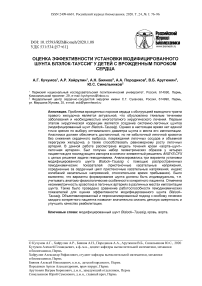Оценка эффективности установки модифицированного шунта Блэлок-Тауссиг у детей с врожденным пороком сердца
Автор: Кучумов А.Г., Хайрулин А.Р., Биянов А.Н., Породиков А.А., Арутюнян В.Б., Синельников Ю.С.
Журнал: Российский журнал биомеханики @journal-biomech
Статья в выпуске: 1 (87) т.24, 2020 года.
Бесплатный доступ
Проблема врожденных пороков сердца с обструкцией выводного тракта правого желудочка является актуальной, что обусловлено тяжелым течением заболевания и необходимостью многоэтапного хирургического лечения. Первым этапом хирургической коррекции является создание системно-легочных шунтов (модифицированный шунт Blalock - Taussig ). Однако в настоящее время нет единой точки зрения по выбору оптимального диаметра шунта и места его имплантации. Анастомоз должен обеспечить достаточный, но не избыточный легочной кровоток без снижения сердечного выброса, повреждения легочных сосудов и объемной перегрузки желудочка, а также способствовать равномерному росту легочных артерий. В данной работе рассмотрена модель течения крови «аорта-шунт-легочная артерия». Был получен набор геометрических образов у четырех пациентов для последующего импорта в конечно-элементный решатель ANSYS CFX с целью решения задачи гемодинамики. Анализировались три варианта установки модифицированного шунта Blalock - Taussig с помощью распространенных гемодинамических показателей (пристеночные касательные напряжения, осредненные за сердечный цикл пристеночные касательные напряжения, индекс колебаний касательных напряжений, относительное время пребывания). Было выявлено, что варианты формирования шунта должны быть индивидуальны, т.е. учитывать анатомо-физиологические особенности конкретного пациента. Отмечена несимметричность кровотока в легочных артериях в различных местах имплантации шунта. Также было проведено сравнение работоспособности гемодинамических показателей для оценки эффективности модифицированного шунта Blalock - Taussig . Объективизированный и персонализированный подход к особому лечению каждого конкретного пациента позволит значительно снизить детскую смертность и улучшить качество реабилитации.
Модифицированный шунт blalock-taussig, кровь, аорта
Короткий адрес: https://sciup.org/146282161
IDR: 146282161 | УДК: 531/534:[57+61] | DOI: 10.15593/RZhBiomeh/2020.1.08
Текст научной статьи Оценка эффективности установки модифицированного шунта Блэлок-Тауссиг у детей с врожденным пороком сердца
Обструктивные поражения выводного тракта правого желудочка, изолированные или сочетающиеся с другими врожденными пороками сердца, составляют 25–30% врожденных аномалий сердца [23]. Врожденная обструкция выводного тракта правого желудочка в зависимости от уровня сужения подразделяется на клапанный, подклапанный стеноз, сужение легочного ствола и периферических ветвей легочной артерии.
Хирургическое лечение как основной метод лечения врожденных пороков сердца с обструкцией выводного тракта правого желудочка может быть представлено радикальной коррекцией или этапным лечением [43]. Прорывным решением в хирургическом лечении цианотических врожденных пороков сердца, таких как тетрада Фалло, атрезия клапана легочной артерии и некоторых других, оказалось создание межсистемного шунта (в частности, модифицированного шунта Blalock–Taussig) [21, 45].
Важно отметить, что модифицированный шунт Blalock–Taussig продолжает оставаться процедурой высокого риска с общей смертностью от 2,3 до 16% [19, 26]. Одна треть смертей приходится на первые сутки после операции и две трети в течение первых 30 дней. Такой уровень смертности конкурирует с риском смертности многих операций неонатального периода на открытом сердце с искусственным кровообращением.
На рис. 1 показана частота случаев смертности у пациентов после установки модифицированного шунта Blalock–Taussig. На рис. 2 представлена частота выживаемости после полного цикла лечения.
Основные осложнения модифицированного шунта Blalock–Taussig связаны с развитием тромбоза шунта при выборе шунта малого диаметра и гиперволемией малого круга при шунте большего диаметра [9, 13, 17, 25, 27]. Тромбоз шунта в раннем послеоперационном периоде встречается в 9,4–13,7% случаев [63].
Поэтому выбор оптимального диаметра шунта является очень важной задачей, которая не решена до настоящего времени. Чаще всего подбор шунта осуществляется эмпирически: для пациентов с массой тела до 3 кг используют шунт размером 3 и 3,5 мм для пациентов с массой тела около 3,5 кг [46]. Ряд других исследователей при выборе размера шунта используют коэффициент 0,9–1,6 мм / кг массы тела. В работах [20, 51] был предложен индекс трансплантата (соотношение площади поперечного сечения трансплантата и площади поверхности тела).
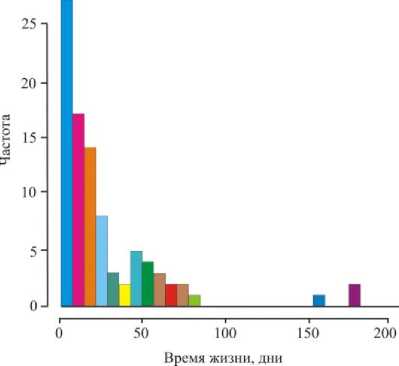
Рис. 1. Показатели смертности у детей после установки модифицированного
Blalock – Taussig шунта [48]
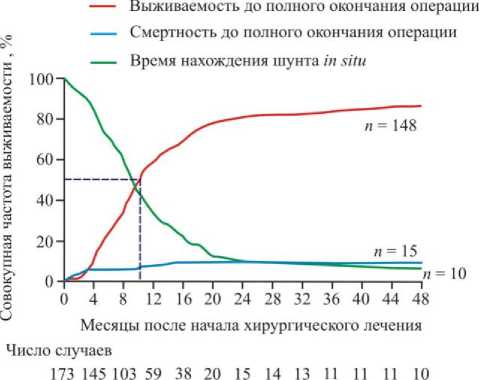
80-
„= 148
60-
40-
20- и = 15
--- Выживаемость до полного окончания операции --- Смертность до полного окончания операции — Время нахождения шунта in situ
। л = 10
" I---------1---------1---------1---------1---------1---------1---------1---------1---------1---------1---------1
0 4 8 12 16 20 24 28 32 36 40 44 48
Месяцы после начала хирургического лечения
Рис. 2. Совокупная частота выживаемости после окончания операции (%) [10]
Число случаев
173 145 103 59 38 20 15 14 13 11 11 И 10
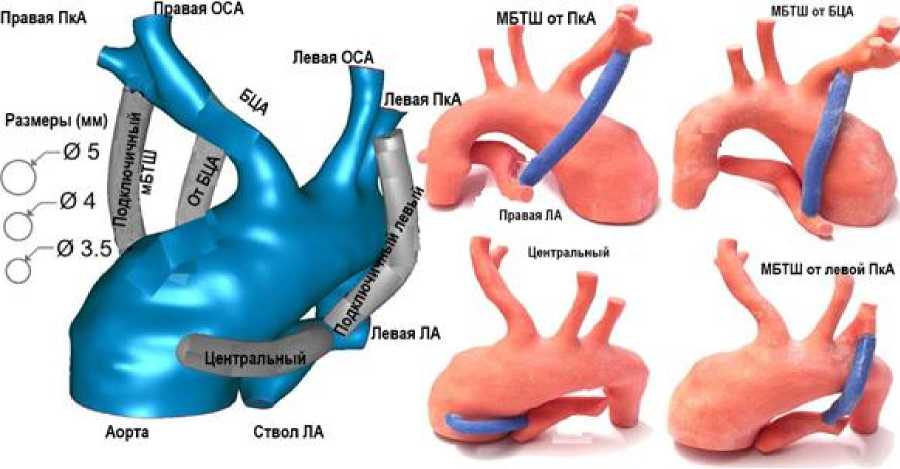
Рис. 3. Варианты установки модифицированного шунта Blalock–Taussig [50] (ОСА – общая сонная артерия, БЦА – брахиоцефальная артерия, ПкА – подключичная артерия, МБТШ – модифицированный шунт Blalock–Taussig )
На рис. 3 показана схема вариантов установки модифицированного шунта Blalock– Taussig .
Учитывая важность индивидуального подбора модифицированного шунта Blalock–Taussig для обеспечения эффективного функционирования, основной научный поиск направлен на создание методик с учётом количественных оценок на основе применения биомеханики и математического моделирования, которые бы смогли учесть все гемодинамические особенности конкретного пациента.
Математическое моделирование и методы биомеханики позволяют оценить прогностические данные, которые не могут обеспечить современные методы визуализации. В настоящее время информационные технологии, разработка эффективных вычислительных алгоритмов позволяют реконструировать реалистичные и точные трехмерные модели, в которых учитывается уровень артериального давления, детальная анатомия, механизмы обратной связи в системе кровообращения и деформации стенки сосуда. У клинициста появляется возможность неинвазивно определить временные и пространственные изменяющиеся гемодинамические параметры, которые не могут быть изучены путем визуализации или клинических измерений [22].
В настоящее время методы вычислительной гидродинамики широко используются в клинической практике [1–8, 30–36]. Одним из направлений применения данных методов является анализ модифицированного шунта Blalock–Taussig . Применение биомеханики и математического моделирования позволяет оценить гемодинамические параметры для различных конфигураций шунтов и углов анастомоза [18, 38, 39, 59, 60] и улучшить понимание патофизиологических процессов в сердечнососудистой системе до/после модифицированного шунта Blalock–Taussig [57, 58].
Целью данной работы является анализ эффективности места установки модифицированного шунта Blalock–Taussig . В качестве критериев рассматриваются основные гемодинамические показатели (пристеночные касательные напряжения, осредненные за сердечный цикл пристеночные касательные напряжения, индекс колебаний касательных напряжений, относительное время пребывания).
Материалы и методы
Пациенты
Мультиспиральная компьютерная томография сердца и магистральных сосудов с контрастом была проведена четырем пациентам, получавшим лечение в Федеральном центре сердечно-сосудистой хирургии им. С.Г. Суханова, с использованием МСКТ-томографа Somatom Definition AS ( Siemens , Германия). Всем пациентам в возрасте до двух недель выполнялась операция шунтирования. Двум пациентам был сформирован шунт между брахиоцефальным стволом и правой легочной артерией диаметром 3,5 мм, одному пациенту 4 мм. В четвертом случае выполнялось формирование центрального шунта 3,5 мм между восходящей аортой и бифуркацией легочных артерий.
Получение набора изображений и 3D-обработка
Всем пациентам в раннем послеоперационном периоде выполнялась мультиспиральная компьютерная томография. Затем с помощью программного продукта ITK-SNAP были построены трехмерные модели аорты с установленными шунтами. Далее для каждой из моделей с помощью обработки в графическом пакете SPACECLAIM были созданы дополнительные варианты установки шунтов (рассматривалось три конфигурации: центральный шунт, левый шунт, правый шунт). На рис. 4 показаны конфигурации шунтов для последующих расчётов. Далее полученные модели были импортированы в ANSYS CFX для последующих расчётов.
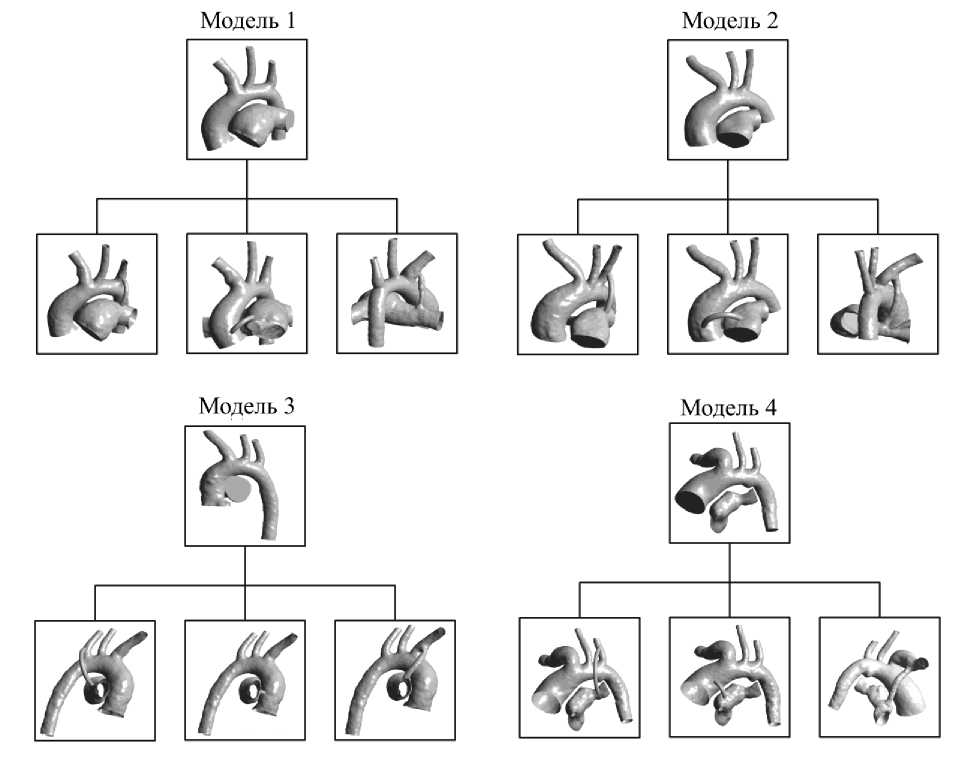
Рис. 4. Варианты установки шунтов для трех рассмотренных пациентов
Сеточная модель
Расчетная сетка моделей была построена с помощью инструментов Body Sizing и Inflation . Body Sizing позволяет устанавливать тип элемента сетки и его размеры. Инструмент Inflation позволяет сгущать сеточную модель в пристеночных областях для дальнейшего выявления пристеночных эффектов.
Сеточные параметры шунта отличались от параметров аорты и легочной артерии. В шунте было увеличено количество элементов ввиду его неоднородной формы для детального рассмотрения распределения параметров кровотока.
Расчетная сетка была выбрана исходя из исследования на сеточную сходимость результатов. В табл. 1 представлены три расчетные сетки с количеством узлов и элементов. Результаты исследования показали, что значения гемодинамических параметров при грубой сетке существенно отличаются от сгущенной сетки. Таким образом, для последующих расчётов использовалась более густая сетка (рис. 5).
Варианты сеточных моделей
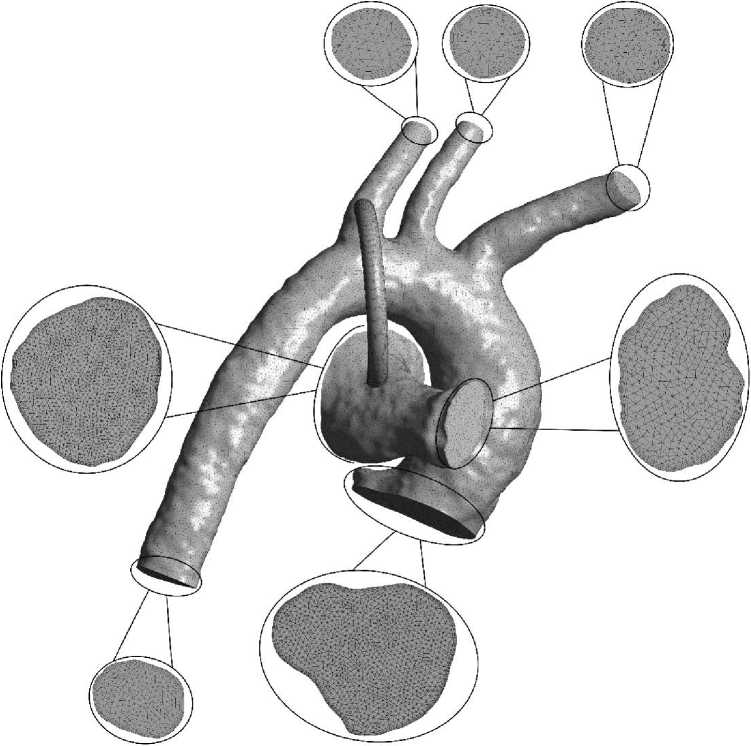
Рис. 5. Сеточная модель
Таблица 1
|
Сетка № 1 |
Сетка № 2 |
Сетка № 3 |
|||
|
Число узлов |
91128 |
Число узлов |
1297348 |
Число узлов |
2668353 |
|
Число элементов |
42259 |
Число элементов |
753514 |
Число элементов |
1639969 |
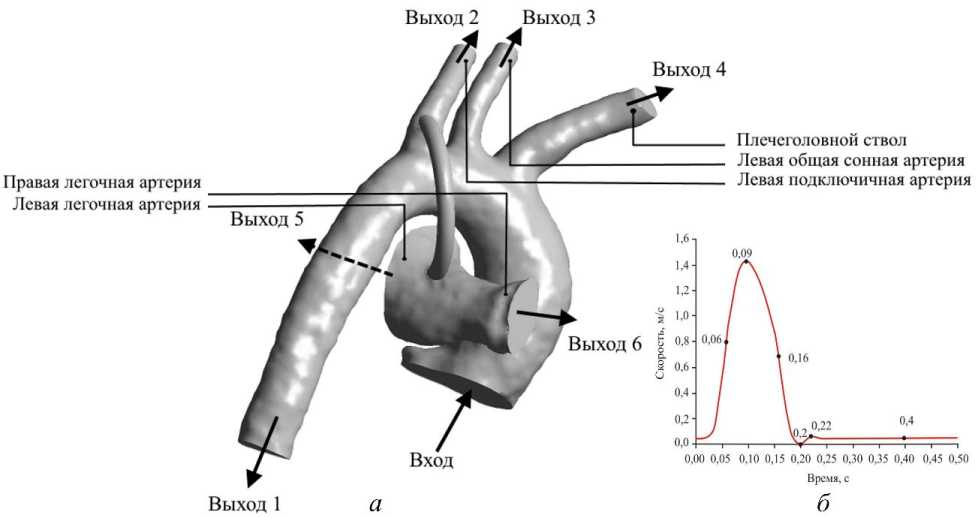
Рис. 6. Граничные условия: а - граничные условия в системе «аорта-легочная артерия», б - профиль скорости на входе
Постановка задачи
Уравнения несжимаемости и Навье-Стокса, описывающие течение крови, могут быть записаны в виде
Р
V-и = 0,
(дU , V7 --+ и - V и
I д t
= V- о + f,
где р - постоянная плотность; и - вектор скорости; ст - тензор напряжений; f - массовые силы. Тензор напряжений может быть разложен на гидростатическую (шаровую) и девиаторные части:
о = - pI + т,
где p - давление; I - единичный тензор; т - девиатор тензора напряжений, который является функцией тензора скорости деформации D, т = п(у)D; П - динамическая вязкость крови; у
скорость сдвига, Y = J—^ZDDa ; D i j ij ji тензор скорости
деформации, D = ^( V и + V uT ) .
Граничные условия
На входе в аорту был поставлен зависящий от времени профиль скорости в период систолической фазы левого желудочка (рис. 6). Период систолы желудочка принимает значение t = 0,288 c (пик систолы - 0,09 с). Пиковая скорость равна 1,4 м/с [40]. На выходах в аорте были заданы постоянные значения давления P = 100 мм рт. ст. (~ 13 332 Па). На выходах в легочной артерии были заданы постоянные значения давления P = 20 мм рт. ст. [28].
Гемодинамические показатели
Величины и характер распределения таких гемодинамических показателей, как пристеночные касательные напряжения ( wall shear stress ), осредненные за сердечный цикл пристеночные касательные напряжения ( time-averaged wall shear stress ), индекс колебаний касательных напряжений ( oscillatory shear index ) и относительное время пребывания ( relative residence time ), позволяют выявить закономерности и характеристики кровотока в артериальных сосудах, а также являются маркерами некоторых патологий, в частности атеросклероза [41, 56]. Низкие значения пристеночных касательных напряжений наблюдаются в бифуркациях и связаны с образованием бляшки при атеросклерозе [44]. Высокие значения индекса колебаний касательных напряжений и относительного времени пребывания наблюдаются в постстенотических областях сосудов и характеризуют эндотелиальную дисфункцию [47, 55]. Эндотелиальная дисфункция является важным предвестником и ранним маркером стенотических изменений и коррегируется на фоне эффективно проводимой терапии.
В работе [16] была выявлена связь между гемодинамическими параметрами (индекс колебаний касательных напряжений и относительного времени пребывания) и показателями ремоделирования сосудов (например, толщины стенки сосуда) при гипертонической болезни.
Пристеночные касательные напряжения
Пристеночные касательные напряжения являются наиболее распространенным гемодинамическим параметром. Касательные напряжения возникают вследствие трения, которое оказывает течение крови на стенку сосуда.
В крупных и прямолинейных кровеносных сосудах непрерывное воздействие касательных напряжений в физиологическом диапазоне способствует установлению нормального тонуса стенки артерии, что дает противовоспалительный и противотромботический эффект.
Для ламинарного течения ньютоновской жидкости пристеночное касательное напряжение сдвига прямо пропорционально градиенту скорости ( ∂u/∂r ) и вязкости жидкости ( μ ):
стенка
Известно, что при низких значениях τ w наблюдается накопление липидов на стенке сосуда [40].
Пристеночные касательные напряжения за сердечный цикл
Пульсирующее течение крови по сосудам характеризуется осредненными за сердечный цикл пристеночными касательными напряжениями, которые могут быть рассчитаны путем интегрирования величины пристеночных касательных напряжений для каждого участка сосуда за время сердечного цикла [42, 53]:

ζ
Значения ниже 0,4 Па способствуют риску развития атеросклероза. Значения более 1,5 Па считаются благоприятными [14]. Значения осредненных за сердечный цикл касательных напряжений от 15 до 45 могут быть тромбогенными и привести к травме эндотелия [54].
Индекс колебаний касательных напряжений
В работе [11] был предложен индекс колебаний касательных напряжений ( OSI ) – безразмерное число, которое показывает изменение направления пристеночных касательных напряжений во время сердечного цикла. Его значение изменяется от 0 до 0,5, где 0 – соответствует однонаправленному течению, а 0,5 – полностью осциллирующему потоку.
OSI =1
Относительное время пребывания
Известно, что при сильно осциллирующих течениях индекс колебательного сдвига может быть таким же, как и при очень медленных потоках. Таким образом, индекс колебательного сдвига не позволяет выявить атероматические области, т.е. области с низкими пристеночными касательными напряжениями и высоким индексом колебательного сдвига на одном и том же участке артериальной системы. Для преодоления вышеуказанных трудностей введено относительное время пребывания ( RRT ) [24]. Относительное время пребывания – это время пролета растворенных веществ и форменных элементов крови в окрестности сосудистого эндотелия. Оно обратно пропорционально продольному расстоянию Δ x , где частица крови перемещается на небольшом расстоянии от стенки [29]:
RRT
A x TAWSS x [ 1 - (2 x OSI ) ] .
Результаты
В результате решения задачи были получены распределения гемодинамических параметров, таких как: скоростные характеристики кровотока, давление на стенки сосуда, пристеночные касательные напряжения, осреднённые за сердечный цикл пристеночные касательные напряжения, индекс колебаний касательных напряжений, относительное время пребывания.
Наиболее интересные результаты были получены в момент времени, соответствующий максимальному значению скорости кровотока.
Распределение давлений
На рис. 7 показано распределение давлений в пиковый момент систолы. Распределение давлений по стенкам аорты и легочной артерии имеет равномерный характер. Наибольшие значения концентрируются на стенках восходящей части аорты, наименьшие же значения наблюдаются на стенках легочной артерии.
В зоне шунта максимальные значения концентрируются в области стыка с аортой, далее давления распределяются равномерно вплоть до легочной артерии при однородной геометрической форме (левостороннее и центральное расположения шунта). Если же шунт имеет неоднородную геометрическую форму, то давления распределяются по шунту неравномерно (правостороннее расположение шунта).
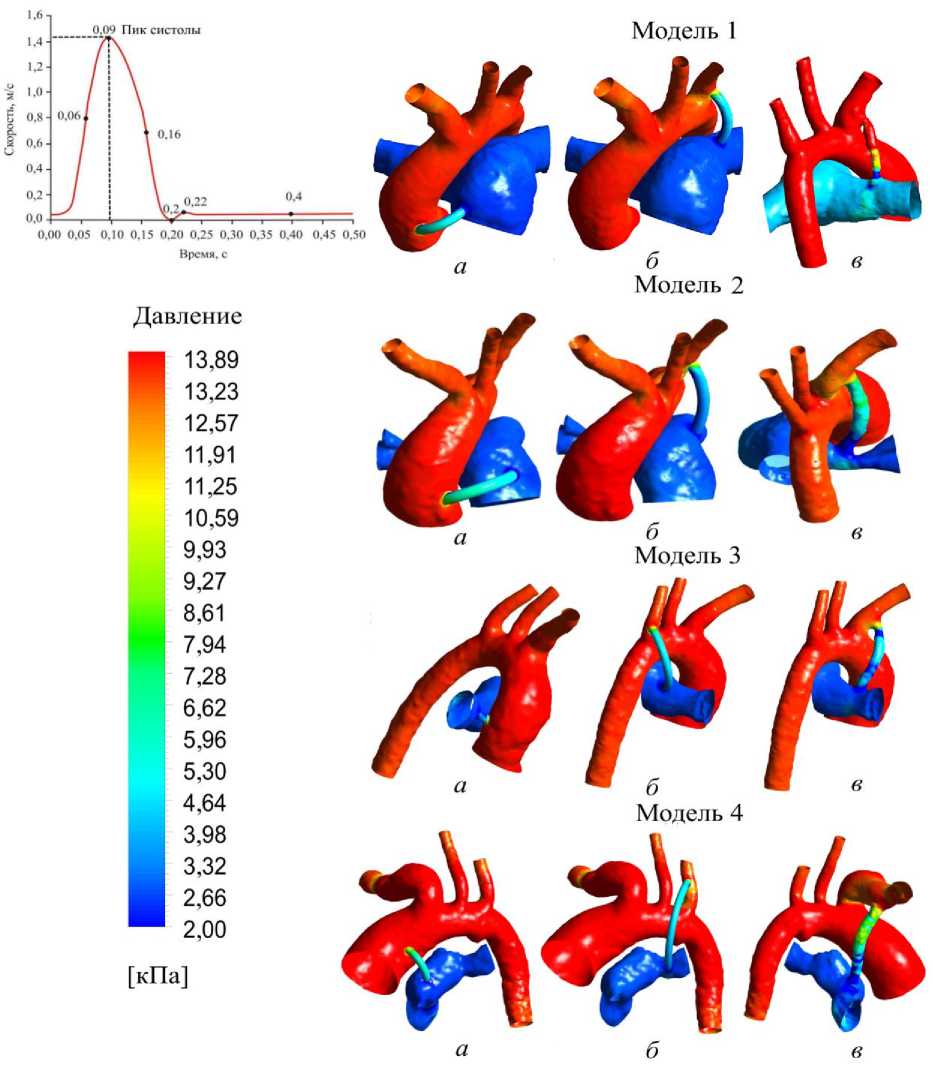
Рис. 7. Распределение давлений: а – центральный шунт; б – правый шунт; в – левый шунт
Распределение скоростей
На рис. 8 показано распределение скоростных характеристик течения крови. В области аорты кровоток имеет равномерный характер распределения. По мере удаления от нисходящей части аорты идет выравнивание скорости кровотока. Обратная ситуация в легочной артерии. В легочной артерии в основном имеется вихревой поток крови за исключением модели 3 ввиду ее геометрических особенностей. В пиковый момент систолы максимальные значения кровотока смещаются в область шунта. Локальные увеличения скорости кровотока характеризуются областями сужения просвета и неоднородностью формы шунта (правостороннее расположение шунта).
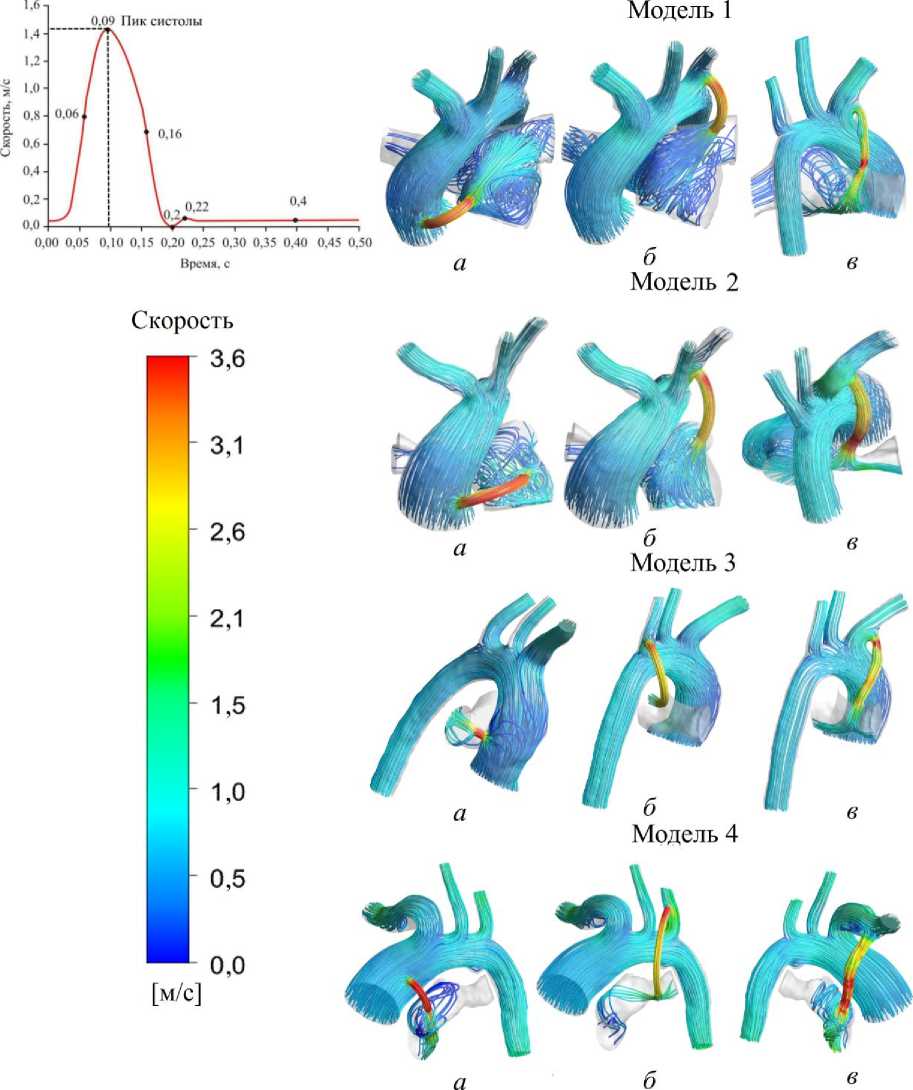
Рис. 8. Распределение скоростей: а – центральный шунт; б – правый шунт; в – левый шунт
Распределение пристеночных касательных напряжений
Распределение касательных напряжений имеет важное значение при изучении системного кровотока [44]. В литературе особое влияние уделяется распределению именно пристеночных касательных напряжений. Большинство авторов связывает гипоплазию интимы сосудистого русла с высокими касательными напряжениями [45].
Высокие значения напряжений связывают с тромбозом и повреждением эндотелия [12]. Низкие же значения напряжений напрямую связывают со стенозом [62].
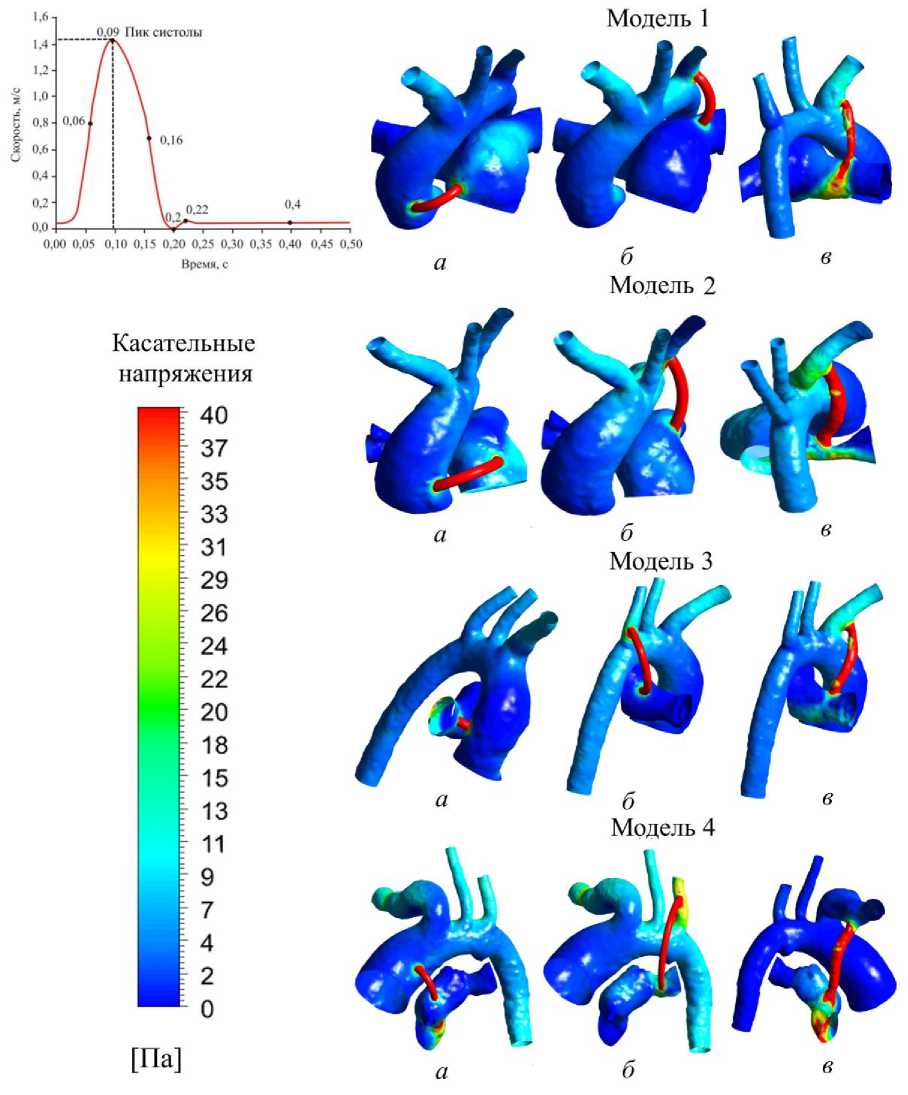
Рис. 9. Распределение пристеночных касательных напряжений: а – центральный шунт; б – правый шунт; в – левый шунт
На рис. 9 показано распределение пристеночных касательных напряжений. Как можно заметить, наибольшие значения локализуются в области шунта, что может приводить к его тромбозу. Также большие значения пристеночных касательных напряжений концентрируются в легочной артерии в области вихревого, застойного потока крови, на ответвлениях аорты (левая подключичная артерия, левая общая артерия и плечеголовной ствол). Минимальные значения наблюдаются в областях нисходящей части аорты, начале правой и левой легочных артерий.
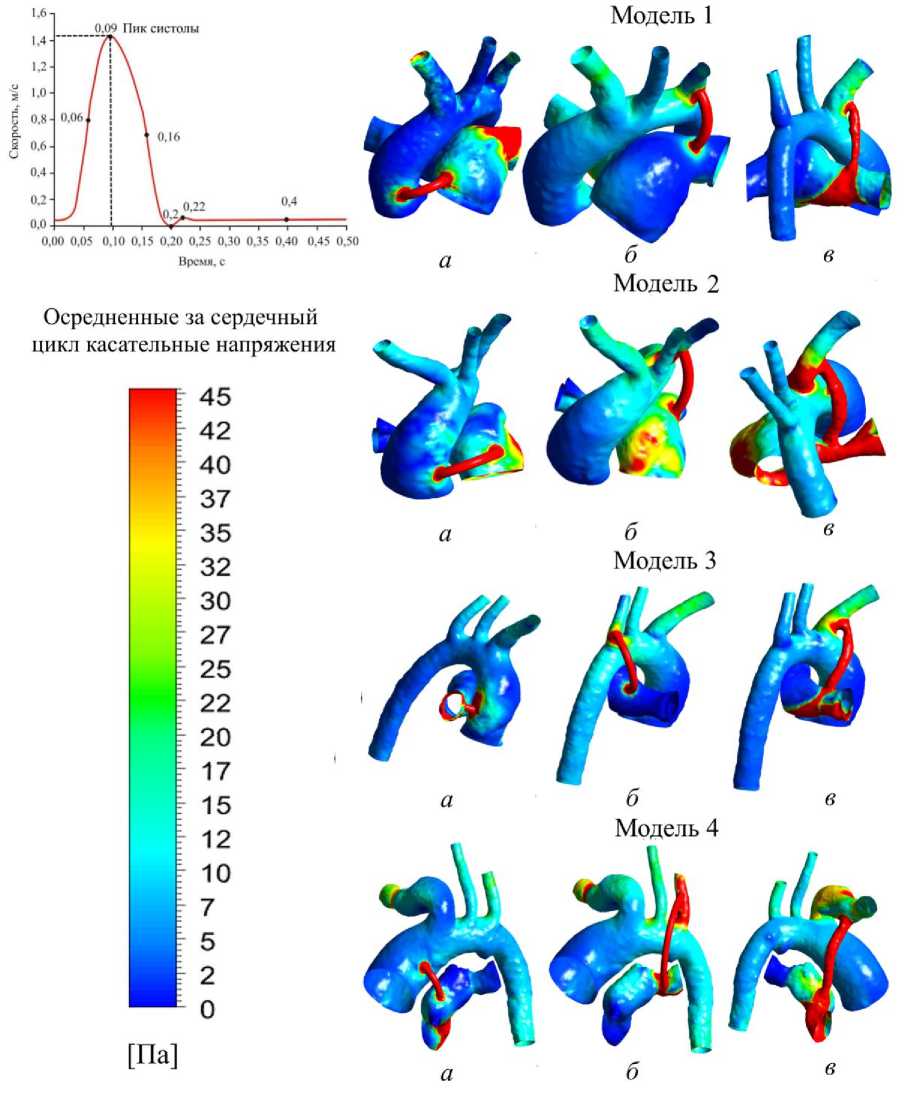
Рис. 10. Распределение осредненных за сердечный цикл пристеночных касательных напряжений: а – центральный шунт; б – правый шунт; в – левый шунт
Распределение осредненных за сердечный цикл касательных напряжений
На рис. 10 показаны осреднённые за сердечный цикл касательные напряжения. Значения осредненных за сердечный цикл касательных напряжений в пиковый момент систолы принимают наибольшие значения в области шунта, тем самым обусловливая тромбоз шунта. Также большие значения локализуются в области вихревого движения крови в низлежащей области легочной артерии. Стоит отметить крайне нерегулярное распределение значений осредненных за сердечный цикл касательных напряжений на модели 2 центрального расположения шунта (см. рис. 10).
Распределение индекса колебаний касательных напряжений
На рис. 11 показано распределение индекса колебаний касательных напряжений, который используется для идентификации областей на стенке сосуда, подверженных сильному колебанию направления вектора пристеночных касательных напряжений во время сердечного цикла (бифуркационных, турбулентных областей) [14].
Значения индекса колебаний касательных напряжений находятся в диапазоне от 0 до 0,5 (безразмерная величина). Значения, близкие к максимальному, характеризуют области вероятного тромбоза. Максимальные значения индекса колебаний касательных напряжений концентрируются в основном на восходящей части аорты, в бифуркационных и вихревых областях легочной артерии.
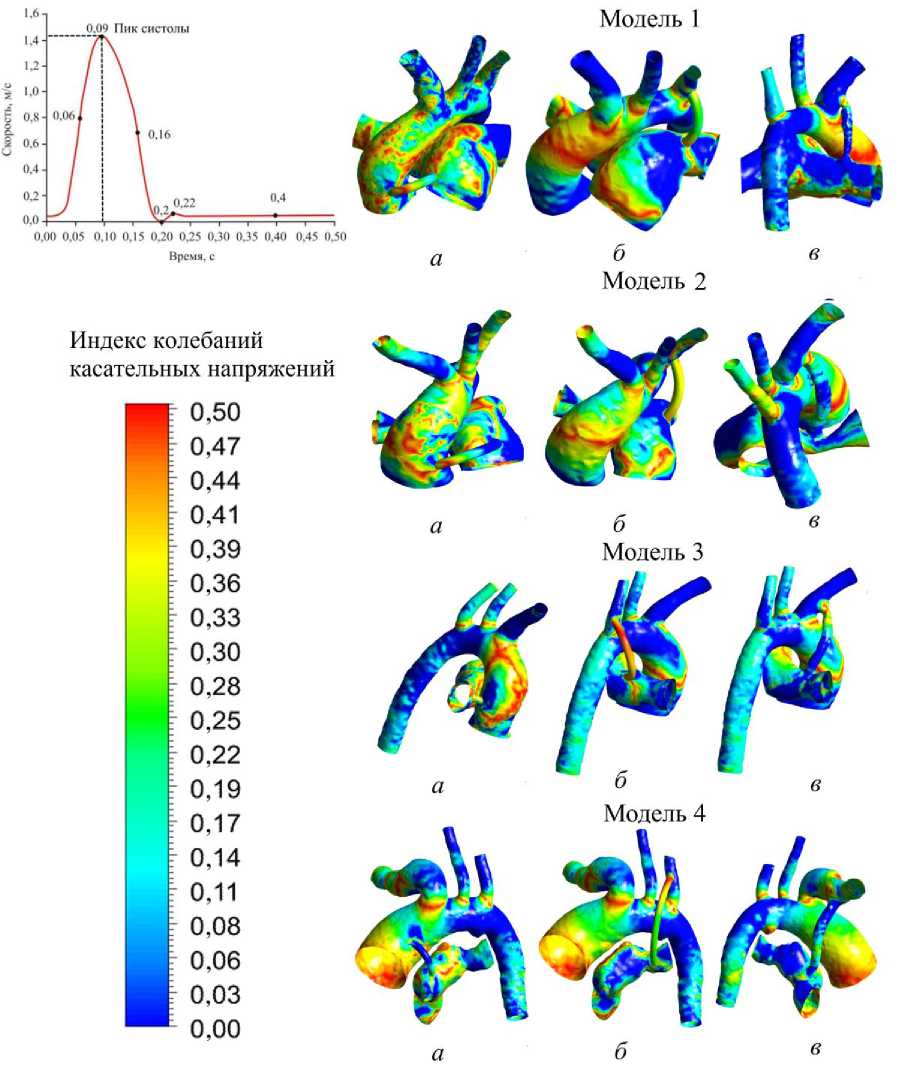
Рис. 11. Распределение индекса колебаний касательных напряжений: а – центральный шунт; б – правый шунт; в – левый шунт
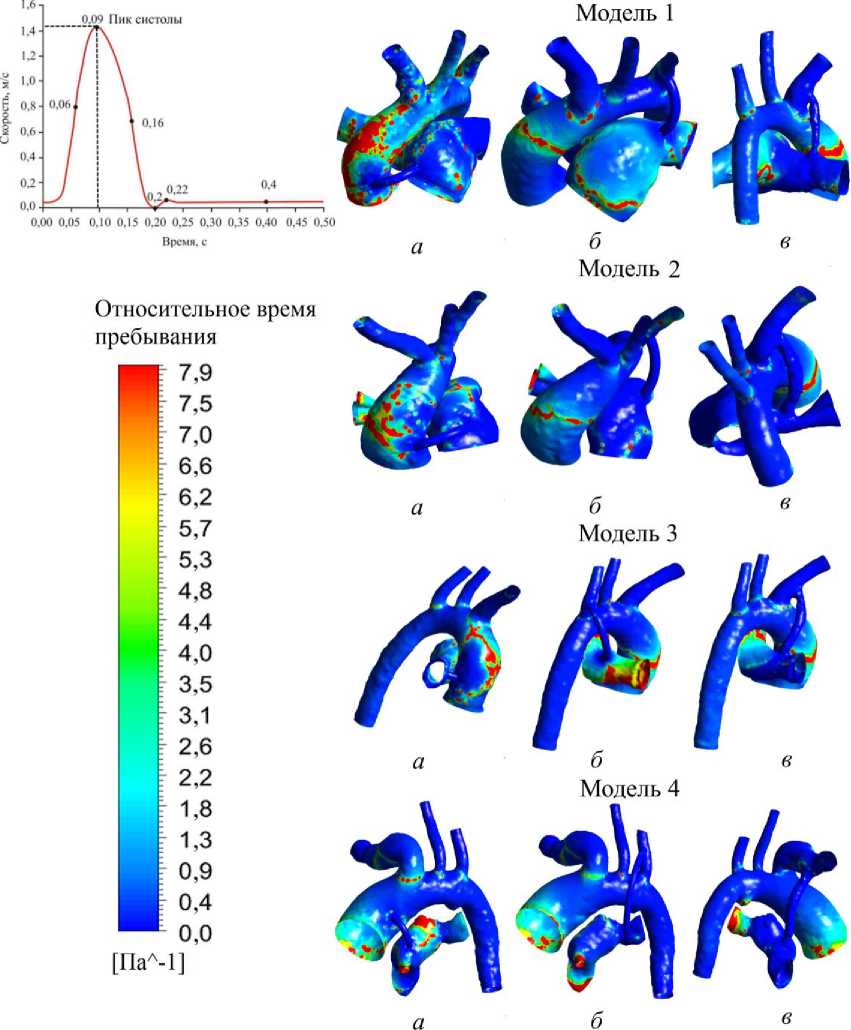
Рис. 12. Распределение показателя относительного времени пребывания: а – центральный шунт; б – правый шунт; в – левый шунт
Снижение значений наблюдается на нисходящей части аорты. Распределение индекса колебаний касательных напряжений в области шунта имеет неравномерный характер. При однородной форме шунта колебания значений происходят в области стыка с аортой (чем ближе к легочному стволу, тем меньше). При неоднородной форме шунта происходит неравномерное распределение значений (колебания максимальных и минимальных значений по всей длине шунта).
Относительное время пребывания
На рис. 12 показано распределение относительного времени пребывания. Значение имеет диапазон от 0 до бесконечности (при индексе колебаний касательных напряжений стремящемся к 0,5). Значение относительного времени пребывания больше 8 считается повышенным [52].
Таблица 2
Анализ эффективности потока по легочным артериям
|
Пациент |
Тип шунта |
||
|
Центральный |
Правый |
Левый |
|
|
1 |
— |
— |
+ |
|
2 |
— |
+ |
— |
|
3 |
– |
+ |
– |
|
4 |
– |
+ |
– |
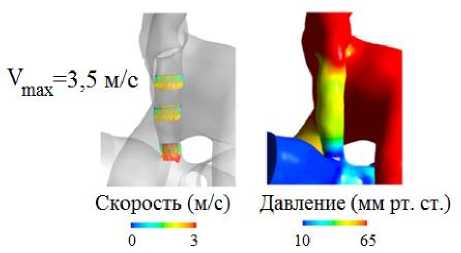
а
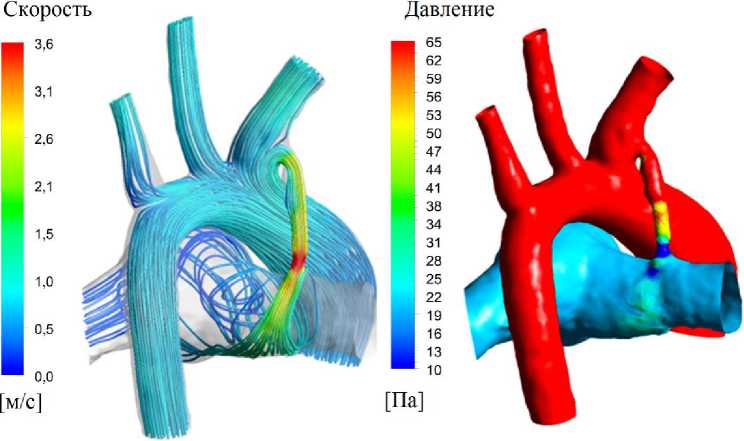
б
Рис. 13. Сравнение данных в работе [18] ( а ) с результатами данной работы ( б )
Большие значения относительного времени пребывания в основном концентрируются на восходящей части аорты. Это связано с непрерывностью кровотока. Также наблюдается колебание значений в областях разделения потока в аорте и в областях вихревого потока в легочной артерии.
Обсуждение
При центральной конфигурации шунта была отмечена несимметричность течения крови по легочным артериям. В левой легочной артерии расход был более чем на 40% выше, чем в правой, что не могло обеспечить адекватное кровоснабжение в малом круге кровообращения (табл. 2). Правое расположение шунта оказалось наиболее благоприятным с точки зрения распределения кровотока. Стоит отметить, что симметричное распределение кровотока в легочных артериях, способствующее росту и развитию правой и левой легочных артерий [61], является одним из главных факторов выбора локализации шунта.
Как можно заметить, распределения давлений и скоростей в системе «аорта – шунт – легочная артерия» хорошо согласуются с имеющимися литературными данными [18] (рис. 13). Максимальные значения давлений наблюдаются в области стыка шунта с аортой, а низкие – в области стыка с легочной артерией. Распределение скоростей также имеет схожий характер. Максимальных значений кровоток достигает в области шунта (значения колеблются в пределах 3,6 м/с).
Стоит отметить, что результаты имеют как качественное, так и количественное согласование, несмотря на различные геометрии моделей и граничные условия.
Гемодинамические показатели очень важны для оценки шунтирования [37]. С точки зрения эффективности шунтирования стоит рассматривать показатели, которые могут описать вероятный риск тромбоза шунта. Такими показателями являются пристеночные касательные напряжения, осредненные за сердечный цикл пристеночные касательные напряжения, индекс колебаний касательных напряжений, относительное время пребывания.
Таблица 3
Сравнение гемодинамических показателей для анализа тромбирования шунта
|
Пациент |
Тип шунта |
Гемодинамические параметры |
|||
|
WSS |
TAWSS |
OSI |
RRT |
||
|
1 |
Центральный |
+ |
+ |
+ |
– |
|
Левый |
+ |
+ |
– |
– |
|
|
Правый |
+ |
+ |
– |
– |
|
|
2 |
Центральный |
+ |
+ |
+ |
– |
|
Левый |
+ |
+ |
– |
– |
|
|
Правый |
+ |
+ |
– |
– |
|
|
3 |
Центральный |
+ |
+ |
– |
– |
|
Левый |
+ |
+ |
+ |
– |
|
|
Правый |
+ |
+ |
– |
– |
|
|
4 |
Центральный |
+ |
+ |
– |
– |
|
Левый |
+ |
+ |
+ |
– |
|
|
Правый |
+ |
+ |
– |
– |
|
Примечание: WSS – пристеночные касательные напряжения, TAWSS – осреднённые за сердечный цикл пристеночные касательные напряжения, OSI – индекс колебаний касательных напряжений, RRT – относительное время пребывания.
В результате анализа распределения показателей была выявлена высокая концентрация пристеночных касательных напряжений, а следовательно, и осредненных за сердечный цикл пристеночных касательных напряжений в области анастомоза во всех моделях. Это, в свою очередь, может свидетельствовать о риске развития тромбоза [44, 49]. Данная оценка подтверждается клиническими и литературными данными [15, 24]. Обратная же ситуация связана с распределением индекса колебаний касательных напряжений и относительного времени пребывания.
Так как скорость в шунте достаточно большая, то можно сделать вывод, что время пребывания частиц вблизи стенки минимальное, о чем и свидетельствует распределение относительного времени пребывания. Высокая концентрация значений индекса колебаний касательных напряжений и относительного времени пребывания локализуется в областях разделения потоков и в восходящей части аорты. Данные области подвержены образованию стеноза [46].
В табл. 3 представлен анализ тромбирования шунта. При рассмотрении таких параметров, как пристеночные касательные напряжения и осредненные за сердечный цикл пристеночные касательные напряжения, выясняется, что риск тромбирования шунта существенен. При рассмотрении индекса колебаний касательных напряжений, выясняется что риску образования тромбоза подвержены первые две модели с центральным расположением шунта и последние две модели с левым расположение шунта. Параметр относительного времени пребывания не выявил каких-либо рисков развития сосудистых заболеваний, т.е. в данном случае его использование не будет эффективным.
Заключение
Проблема, с которой сталкиваются врачи, связана с объективизацией оперативного вмешательства при оценке влияния параметров шунта и места его установки на легочной кровоток у детей с врожденными патологиями сердца. В данной работе рассмотрена модель течения крови «аорта–шунт–легочная артерия». Был получен набор геометрических образов у четырех пациентов для последующего импорта в конечно-элементный решатель ANSYS CFX с целью решения задачи гемодинамики. Анализировались три варианта установки модифицированного шунта Blalock – Taussig с помощью распространённых гемодинамических показателей (пристеночные касательные напряжения, осредненные за сердечный цикл пристеночные касательные напряжения, индекс колебаний касательных напряжений, относительное время пребывания). Было показано, что для различных пациентов варианты установки шунта будут отличаться. Кроме того, отмечена несимметричность течения в легочных артериях в различных местах имплантации. Также было проведено сравнение работоспособности гемодинамических показателей для оценки эффективности модифицированного шунта Blalock – Taussig . Объективизированный и персонализированный подход к особому лечению каждого конкретного пациента позволит значительно снизить детскую смертность и улучшить качество реабилитации.
Благодарности
Часть работы выполнена при поддержке гранта на развитие научной школы Пермского края «Компьютерная биомеханика и цифровые технологии в биомедицине». Часть работы выполнена в рамках международного научно-образовательного сотрудничества по программе «Михаил Ломоносов».
С. 240–242.
Список литературы Оценка эффективности установки модифицированного шунта Блэлок-Тауссиг у детей с врожденным пороком сердца
- Ивонина Е.В., Кучумов А.Г. Течение патологической желчи как жидкости Каро в трубке с сужающимися стенками // Прикладная математика, механика и процессы управления. - 2014. -Т. 1. - С. 40-41.
- Кучумов А.Г., Няшин Ю.И., Самарцев В.А., Гаврилов В.А., Менар М. Биомеханический подход к моделированию билиарной системы как шаг в направлении к построению виртуальной модели физиологии человека // Российский журнал биомеханики. - 2011. - Т. 15, № 2. - С. 32-48.
- Кучумов А.Г. Математическое моделирование перистальтического течения литогенной желчи через проток при рубцовом стенозе, рассматриваемый в виде трубки с сужающимися стенками конечной длины // Российский журнал биомеханики. - 2016. - Т. 20, № 2. - С. 96-115.
- Кучумов А.Г., Самарцев В.А., Няшин Ю.И., Породиков А.А. Применение методов вычислительной гидродинамики в решении актуальных задач хирургии // Современный мир, актуальные вопросы биоэтики, молекулярной и персонализированной медицины: материалы Международного евроазиатского конгресса по вопросам биоэтики, молекулярной и персонализированной медицины "Biomed-inn-2019" / под ред. И.П. Корюкиной, Ю.В. Каракуловой, В.Ю. Мишланова, Е.Г.Фурмана. -2019. - С. 92-96.
- Кучумов А.Г., Няшин Ю.И., Самарцев В.А., Гаврилов В.А., Ивонина Е.В. Перистальтическое течение патологической желчи при рубцовом стенозе большого дуоденального сосочка // Российский журнал биомеханики. - 2014. - Т. 18, № 4. - С. 441-451.
- Перетягин М.А., Кучумов А.Г. Исследование течения желчи в желчевыводящих путях с учетом взаимодействия "жидкость - твердое тело" // Математическое моделирование в естественных науках. - 2016. - Т. 1. - С. 524-525.
- Самарцев В.А., Кучумов А.Г., Няшин Ю.И. Биомеханическое моделирование течения желчи в холедохе при холедохолитиазе в рамках проекта "VIRTUAL PHYSIOLOGICAL HUMAN" // Пермский медицинский журнал. - 2015. - Т. 32, № 4. - С. 51-56.
- Хайрулин А.Р., Кучумов А.Г., Породиков А.А. Персонализированная модель кровообращения у детей с врождённым пороком сердца для оценки эффективности шунтирования // XII Всерос. съезд по фундаментальным проблемам теоретической и прикладной механики: сб. тр. - 2019. -С. 240-242.
- Ahmad U., Fatimi S.H., Naqvi I. Modified Blalock-Taussig shunt: immediate and short-term follow-up results in neonates // Heart Lung Circ. - 2008. - Vol. 17. - P. 54-58.
- Alsoufi B., Gillespie S., Mori M., Clabby M., Kanter K., Kogon B. Factors affecting death and progression towards next stage following modified Blalock-Taussig shunt in neonates // Eur. J. Cardiothorac. Surg. -2016. - Vol. 50. - 169-77.
- Amaya R., Cancel L.M., Tarbell J.M. Interaction between the stress phase angle (SPA) and the oscillatory shear index (OSI) affects endothelial cell gene expression. - 2016. - Vol. 11. DOI: 10.1371/journal.pone.0166569
- Birchall D., Zaman A., Hacker J., Davies G., Mendelow D. Analysis of haemodynamic disturbance in the atherosclerotic carotid artery using computational fluid dynamics // Eur. Radiol. - 2006. - Vol. 16. - P. 10741083.
- Bove T., Vandekerckhove K., Panzer J., De Groote K., Wolf D., François K. Disease-specific outcome analysis of palliation with the modified Blalock-Taussig shunt // World J. Pediatr. Congenit. Heart Surg. -2015. - Vol. 6. - P. 67-74.
- Caro C.G. Discovery of the role of wall shear in atherosclerosis // Arterioscler. Thromb. Vasc. Biol. -2009. - Vol. 29. - P. 158-161.
- Ceresnak S.R., Quaegebeur J.M., Pass R.H. The palliative arterial switch procedure for single ventricles: are these patients suitable Fontan candidates? // Ann. Thorac. Surg. - 2008. - Vol. 86(2). - P. 583-587.
- Chen Z., Yu H., Shi Y., Zhu M., Wang Y., Hu X., Zhang Y., Chang Y., Xu M., Gao W. Vascular remodelling relates to an elevated oscillatory shear index and relative residence time in spontaneously hypertensive rats // Scientific Reports. - 2017. - Vol. 7(1). - P. 1-10.
- Chittithavorn V., Duangpakdee P., Rergkliang C., Pruekprasert N. Risk factors for in-hospital shunt thrombosis and mortality in patients weighing less than 3 kg with functionally univentricular heart undergoing a modified Blalock-Taussig shunt // Interact. Cardiovasc. Thorac. Surg. - 2017. - Vol. 25(3). - P. 407-413.
- Corsini C., Migliavacca F., Hsia T., Pennati G. The influence of systemic-to-pulmonary arterial shunts and peripheral vasculatures in univentricular circulations: focus on coronary perfusion and aortic arch hemodynamics through computational multi-domain modeling // J. Biomech. - 2018. - Vol. 79. - P. 97-104.
- Curzon C.L., Milford-Beland S., Li J.S. Cardiac surgery in infants with low birth weight is associated with increased mortality: analysis of the Society of Thoracic Surgeons Congenital Heart Database // J. Thorac. Cardiovasc. Surg. - 2008. - Vol. 135. - P. 546 -555.
- Dave H.H. Modified Blalock-Taussig shunt: simple but unpredictable // Eur. J. Cardiothorac. Surg. -2016. - Vol. 50(1). - P. 178-179.
- de Leval M.R., McKay R., Jones M., Stark J., Macartney F.J. Modified Blalock-Taussig shunt. Use of subclavian artery orifice as flow regulator in prosthetic systemic-pulmonary artery shunts // Thorac. Cardiovasc. Surg. - 1981. - Vol. 81(1). - P. 112-119.
- DeCampli W.M., Ricardo Argueta-Morales I., Divo E., Kassab A.J. Computational fluid dynamics in congenital heart disease // Cardiol. Young. - 2012. - Vol. 22(6). - P. 800-808.
- Driscoll D.J., Michels V.V., Gersony W.M. Occurrence risk for congenital heart defects in relatives of patients with aortic stenosis, pulmonary stenosis, or ventricular septal defect // Circulation. - 1993. -Vol. 87. - P. 114-120.
- Findlow D., Doyle E. Congenital heart disease in adults // British Journal of Anaesthesia. - 1997. -Vol. 78. - P. 416-430.
- Gedicke M., Morgan G., Parry A., Martin R., Tulloh R. Risk factors for acute shunt blockage in children after modified Blalock-Taussig shunt operations // Heart Vessels. - 2010. - Vol. 25(5). - P. 405-409.
- Gold J.P., Violaris K., Engle M.A. A five-year clinical experience with 112 Blalock-Taussig shunts // J. Card. Surg. - 1993. - Vol. 8. - P. 9-17.
- Hanley F.L., Sade R.M., Blackstone E.H., Kirklin J.W., Freedom R.M., Nanda N.C. Outcomes in neonatal pulmonary atresia with intact ventricular septum. A multiinstitutional study // J. Thorac. Cardiovasc. Surg. -1993. - Vol. 105. - P. 406 -423.
- Heresi G.A., Minai O.A., Tonelli A.R., Hammel J.P., Farha S., Parambil J.G., Dweik R.A. Clinical characterization and survival of patients with borderline elevation in pulmonary artery pressure // Pulmonary Circulation. - 2013. - Vol. 3(4). - P. 916-925.
- Himburg H.A., Grzybowski D.M., Hazel A.L. Spatial comparison between wall shear stress measures and porcine arterial endothelial permeability // Am. J. Physiol. Heart Circ. Physiol. - 2004. - Vol. 33. - P. 19161922.
- Kuchumov A.G., Selyaninov A. Application of computational fluid dynamics in biofluids simulation to solve actual surgery tasks // Advances in intelligent systems and computing. - 2020. - Vol. 1018. - P. 576-580.
- Kuchumov A. Patient-specific bile flow simulation to evaluate cholecystectomy outcome // IOP Conference Series: Materials Science and Engineering. - 2019. - P. 012022.
- Kuchumov A.G., Nyashin Y.I., Samartsev V.A. Modelling of peristaltic bile flow in the papilla ampoule with stone and in the papillary stenosis case: application to reflux investigation // IFMBE Proceedings 7th WACBE World Congress on Bioengineering. - 2015. - P. 158-161.
- Kuchumov A. Biomechanical modelling of bile flow in the biliary system // MATEC Web of Conferences. -2018. - Vol. 13. - P. 04004.
- Kuchumov A., Tuktamyshev V., Kamaltdinov M. Peristaltic flow of lithogenic bile in the Vateri's papilla as non-Newtonian fluid in the finite-length tube: analytical and numerical results for reflux study and optimization // Lekar a Technika. - 2017. - Vol. 47(2). - P. 35-42.
- Kuchumov A.G., Gilev V., Popov V., Samartsev V., Gavrilov V. Non-Newtonian flow of pathological bile in the biliary system: experimental investigation and CFD simulations // Korea-Australia Rheology Journal. - 2014. - Vol. 26. - P. 81-90.
- Kuchumov A.G., Nyashin Y.I., Samarcev V.A., Gavrilov V.A. Modelling of the pathological bile flow in the duct with a calculus // Acta of Bioengineering and Biomechanics. - 2013. - Vol. 15(4). - P. 9-17.
- Li J.S., Yow E., Berezny K.Y. Clinical outcomes of palliative surgery including a systemic-to-pulmonary artery shunt in infants with cyanotic congenital heart disease: does aspirin make a difference? // Circulation. - 2007. - Vol. 116. - P. 293-307.
- Liu J., Sun Q., Umezu M., Qian Y., Hong H., Du Z. Influence of conduit angles on hemodynamics of modified Blalock-Taussig shunt: Computational analysis of patient-specific virtual procedures // Commun. Comput. Inf. Sci. - 2014. - Vol. 461. - P. 62-71.
- Liu J., Sun Q., Hong H., Sun Y., Liu J., Qian Y. Medical image-based hemodynamic analysis for modified Blalock-Taussig shunt // J. Mech. Med. Biol. - 2015. - Vol. 15(3). - P. 1-17.
- Madhavan S., Kemmerling E. The effect of inlet and outlet boundary conditions in image-based CFD modeling of aortic flow // Biomedical Engineering Online. - 2018. - Vol. 17(1). - P. 66-72.
- Malek A.M., Jackman R., Rosenberg R.D., Izumo S. Endothelial expression of thrombomodulin is reversibly regulated by fluid shear stress // Circ. Res. - 1994. - Vol. 74. - P. 852-860.
- Malek A.M., Alper S.L., Izumo S. Hemodynamic shear stress and its role in atherosclerosis // JAMA. -1999. - Vol. 282. - P. 2035-2042.
- McKenzie E.D., Khan M.S., Samayoa A.X. The Blalock-Taussig shunt revisited: a contemporary experience // J. Am. Coll. Surg. - 2013. - Vol. 216(4). - P. 699-704.
- Morbiducci U., Gallo D., Massai D., Consolo F., Ponzini R., Antiga L., Bignardi C., Deriu M.A., Redaelli A. Outflow conditions for image-based haemodynamic models of the carotid bifurcation. implications for indicators of abnormal flow // J. Biomech. Eng. - 2010. - Vol. 132. - P. 1-11.
- Moulton A.L., Brenner J.I., Ringel R. Classic versus modified Blalock-Taussig shunts in neonates and infants // Circulation. - 1985. - Vol. 72. - P. 35- 44.
- Myers J.W., Ghanayem N.S., Cao Y. Outcomes of systemic to pulmonary artery shunts in patients weighing less than 3 kg: analysis of shunt type, size, and surgical approach // J. Thorac. Cardiovasc. Surg. - 2014. -Vol. 147. - P. 672-677.
- Papaioannou T.G., Stefanadis C. Vascular wall shear stress: basic principles and methods // Hellenic J. Cardiol. - 2005. - Vol. 46(1). - P. 9-15.
- Petrucci O., O'Brien S.M., Jacobs M.L., Jacobs J.P., Manning P.B., Eghtesady P. Risk factors for mortality and morbidity after the neonatal Blalock-Taussig shunt procedure // Ann. Thorac. Surg. - 2011. -Vol. 92(2). - P. 642-651.
- Pinto S.S., Campos J. Numerical study of wall shear stress-based descriptors in the human left coronary artery // Computer Methods in Biomechanics and Biomedical Engineering. - 2016. - Vol. 19(13). -P. 1443-1455.
- Piskin S., Altin H.F., Yildiz O., Bakir I., Pekkan K. Hemodynamics of patient-specific aorta-pulmonary shunt configurations // J. Biomech. - 2017. - Vol. 50. - Vol. 166-171.
- Shibata M., Itatani K., Oka N., Yoshii T., Nakamura Y., Kitamura T., Horai T., Miyaji K. Optimal graft size of modified Blalock-Taussig shunt for biventricular circulation in neonates and small infants // Int. Heart J. - 2015. - Vol. 56(5). - P. 533-536.
- Sugiyama S.I., Niizuma K., Nakayama T., Shimizu H., Endo H., Inoue T., Fujimura M., Ohta M., Takahashi A., Tominaga T. Relative residence time prolongation in intracranial aneurysms: a possible association with atherosclerosis // Neurosurgery. - 2013. - Vol. 73, No. 5. - P. 767-776.
- Tempe D.K., Virmani S. Coagulation abnormalities in patients with cyanotic congenital heart disease // J. Cardiothorac. Vasc. Anesth. - 2002. - Vol. 16(6). - P. 752-765.
- Toloui M., Firoozabadi B., Saidi M.S. A numerical study of the effects of blood rheology and vessel deformability on the hemodynamics of carotid bifurcation // Scientia Iranica B. - 2012. - Vol. 19(1). -P. 119-126.
- Traub O., Berk B.C. Laminar shear stress: mechanisms by which endothelial cells transduce an atheroprotective force // Arterioscler. Thromb. Vasc. Biol. - 1998. - Vol. 18(5). - P. 677-685.
- Watanabe M., Aoki M., Fujiwara T. Thrombotic occlusion of Blalock- Taussig shunt in a patient with unnoticed protein C deficiency // Gen. Thorac. Cardiovasc. Surg. - 2008. - Vol. 56. - P. 544-546.
- Williams J.A., Bansal A.K., Kim B.J. Two thousand Blalock-Taussig shunts: a six-decade experience // Ann. Thorac. Surg. - 2007. - Vol. 84. - P. 2070-2075.
- Zahorec M., Hrubsova Z., Skrak P., Poruban R., Nosal M., Kovacikova L. A comparison of Blalock-Taussig shunts with and without closure of the ductus arteriosus in neonates with pulmonary atresia // Ann. Thorac. Surg. - 2011. - Vol. 92(2). - P. 653-658.
- Zhang N., Yuan H., Chen X., Liu J., Zhou C., Huang M. Hemodynamic of the patent ductus arteriosus in neonates with modified Blalock-Taussig shunts // Comput. Methods Programs Biomed. - 2020. -Vol. 186. - P. 105223.
- Zhao X., Liu Y., Ding J., Ren X., Bai F., Zhang M. Hemodynamic effects of the anastomoses in the modified Blalock-Taussig shunt: a numerical study using a 0D/3D coupling method // J. Mech. Med. Biol. - 2015. -Vol. 15(1). - P. 1-19.
- Zhou T., Wang Y., Liu J., Wang Y., Wang Y., Chen S., Zhou C., Dong N. Pulmonary artery growth after modified Blalock-Taussig shunt: A single center experience // Asian Journal of Surgery. - 2020. - Vol. 43(2). - P. 428-437.
- Younis H.F., Kaazempur-Mofrad M.R., Chung C., Chan R.C., Kamm R.D. Computational analysis of the effects of exercise on hemodynamics in the carotid bifurcation // Annals of Biomedical Engineering. -2003. - Vol. 31. - P. 995-1006.
- Wells W.J., Yu R.J., Batra A.S., Monforte H., Sintek C., Starnes V.A. Obstruction in modified Blalock shunts: a quantitative analysis with clinical correlation // Ann. Thorac. Surg. - 2005. - Vol. 79. - P. 2072-2076.

